Threatened powerful owl hatches in Sydney’s Centennial Parklands
Centennial Parklands is proving more than just a drawcard for inner city families and visitors — a threatened species of owl has successfully hatched for the first time at the expansive green space.
Centennial Parklands is proving more than just a drawcard for inner city families and visitors — a threatened species of owl has successfully hatched for the first time at the expansive green space.
The arrival of a powerful owl chick has caused a flurry of excitement for park officials and visitors alike, with the eight-month-old fledgling recently seen venturing beyond its nesting ground at the parklands.
Known for their striking yellow eyes and reddish white plumages, powerful owls are Australia’s largest owl variety, growing up to 60cm tall.

Centennial Park conservation officer Amara Glynn said the chick has started to transition in plumage and is “looking more grown-up”.
“The chick is already quite large and has recently been seen begging its parents for food — it’s caused a lot of excitement,” Ms Glynn said.
IN OTHER NEWS
“We only started to record powerful owls in the park in 2014, but this is the first time a breeding has been successful. We think the weaning process would have started and the chick will soon be learning to hunt on its own.”
There are only around 5000 known powerful owls in the wild with the majority found in NSW.

Ms Glynn said potential factors for the breeding pair selecting the park for its nest included habitat removal and loss of older trees needed for large nesting hollows.
“With urban development the parklands has become a real refuge for wildlife,” she said.
“It has a diverse range of habitats — ponds, waterways, grassland and bushland areas — and also a good source of food for the owls (including flying foxes and brush-tailed possums).”
Park staff took extra precautions to protect the nesting area including creating a “no-mowing zone” and keeping the news of the arrival under wraps from the public for the first several months.
Monitoring included looking at the owls’ behaviour, types of prey they are catching, and which trees are selected for nests.
“The owls in the park seem to be very happy around people — we hope this is the first of many arrivals to come,” Ms Glynn said.
“It’s really satisfying to see conservation success — particularly for a threatened species. It highlights the importance of having parklands in our urban environment.”


